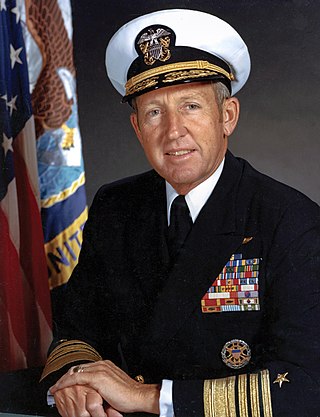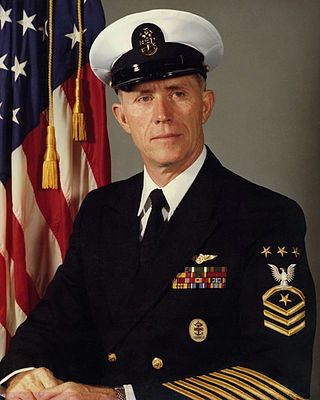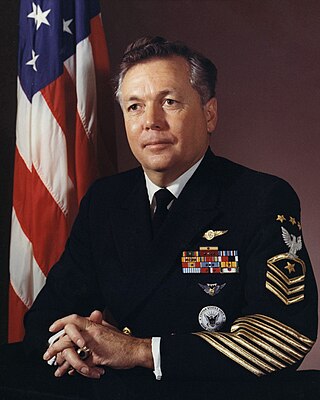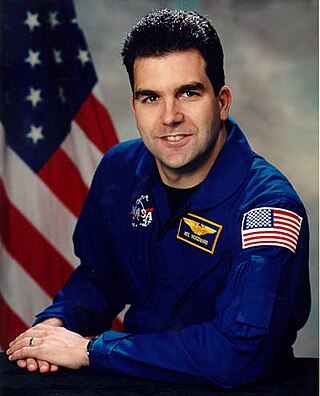
John Henry Towers CBE was a highly decorated United States Navy four-star admiral and pioneer naval aviator. He made important contributions to the technical and organizational development of naval aviation from its beginnings, eventually serving as Chief of the Bureau of Aeronautics (1939–1942). He commanded carrier task forces during World War II, and retired in December 1947. He and Marc Mitscher were the only early Naval Aviation pioneers to survive the hazards of early flight to remain with naval aviation throughout their careers. Towers spent his last years supporting aeronautical research and advising the aviation industry.
A naval flight officer (NFO) is a commissioned officer in the United States Navy or United States Marine Corps who specializes in airborne weapons and sensor systems. NFOs are not pilots (naval aviators), but they may perform many "co-pilot" or "mission specialist" functions, depending on the type of aircraft. Until 1966, their duties were performed by both commissioned officer and senior enlisted naval aviation observers (NAO).

Naval Air Station North Island or NAS North Island, at the north end of the Coronado peninsula on San Diego Bay in San Diego, California, is part of the largest aerospace-industrial complex in the United States Navy – Naval Base Coronado (NBC), and the home port of several aircraft carriers of the United States Navy.

Naval Air Station (NAS) Oceana or NAS Oceana is a United States Navy Naval Air Station located in Virginia Beach, Virginia.

Admiral Thomas Bibb Hayward was Chief of Naval Operations for the United States Navy from July 1, 1978, until June 30, 1982, after which he retired from military service.

Billy C. Sanders is a retired senior sailor of the United States Navy who served as the fifth Master Chief Petty Officer of the Navy.

John Donaldson Whittet was a senior sailor in the United States Navy who served as the second Master Chief Petty Officer of the Navy.

Attack Squadron 42 (VA-42) was a United States Navy attack squadron based at Naval Air Station Oceana, Virginia. The squadron was established as Fighter Squadron 42 (VF-42) on 1 September 1950, redesignated as VA-42 on 1 November 1953 and disestablished on 30 September 1994.

Training Squadron EIGHT SIX (VT-86), also known as the "Sabrehawks," is a United States Navy advanced jet training squadron based at the Naval Air Station Pensacola, Florida. Training Squadron 86 is a tenant command of Training Air Wing 6. They are a training squadron flying the T-45C Goshawk. Their tailcode is F and their radio callsign is ROKT.

Neil W. Woodward III is an American Naval officer and a former NASA astronaut.

Ralph Andrew Ofstie was a Vice Admiral in the United States Navy, an escort carrier commander in World War II, Deputy Chief of Naval Operations (Air), and Commander of the U.S. Sixth Fleet. He was born in Eau Claire, Wisconsin and his hometown was Everett, Washington.

George John Dufek was an American naval officer, naval aviator, and polar expert. He served in World War II and the Korean War and in the 1940s and 1950s spent much of his career in the Antarctic, first with Admiral Byrd and later as supervisor of U.S. programs in the South Polar regions. Rear Admiral Dufek was the director of the Mariners' Museum in Newport News, Virginia after his retirement from the Navy in 1959.

Admiral Richard Michael Dunleavy is a retired US naval officer. He retired as a two-star rear admiral in 1992 after being demoted from the rank of three-star vice admiral as a result of the Tailhook scandal.
The US Navy had four programs for the training of naval aviators.

James Edward Service was a vice admiral of the United States Navy active during much of the Cold War. A naval aviator, he flew combat missions in the Korean War and Vietnam War, commanded aviation units and various ships including aircraft carriers, served as a test pilot, and was President of the Naval War College.

Frederick Charles Turner was a highly decorated officer in the United States Navy with the rank of vice admiral. Turner began his career as Reservist and naval aviator during World War II and distinguished himself during Battles of Iwo Jima and Okinawa in early 1945. Following the War, Turner remained in the Navy and commanded aircraft carrier USS America during Vietnam War.

Thomas Albert Cropper is an American retired United States Navy rear admiral and academic administrator serving as president of the California State University Maritime Academy. Cropper was appointed on July 1, 2012 with the rank of honorary rear admiral in the U.S. Maritime Service.

Dell David Bull is a retired United States Navy Rear Admiral and Naval Flight Officer bombardier/navigator currently assigned as Deputy Director for Operations and Intelligence Integration at the Joint Improvised-Threat Defeat Organization (JIDO). He previously served as Special Assistant for Naval Air Systems Command in Washington, D.C. From July 2015 to June 2017, Bull was Chief of Naval Air Training at Naval Air Station Corpus Christi.

Dee Leon Mewbourne is a retired United States Navy vice admiral who served as 16th deputy commander of United States Transportation Command between July 2, 2019 and June 29, 2022.


















